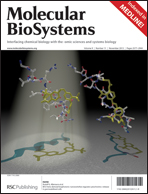Identification of hepatocellular carcinoma related genes with k-th shortest paths in a protein–protein interaction network†
Abstract
Hepatocellular carcinoma (HCC) is the most common type of liver cancer worldwide and one of the deadliest cancers in Asia. But at present, effective targets for HCC clinical therapy are still limited. The “guilt by association” rule suggests that interacting


 Please wait while we load your content...
Please wait while we load your content...